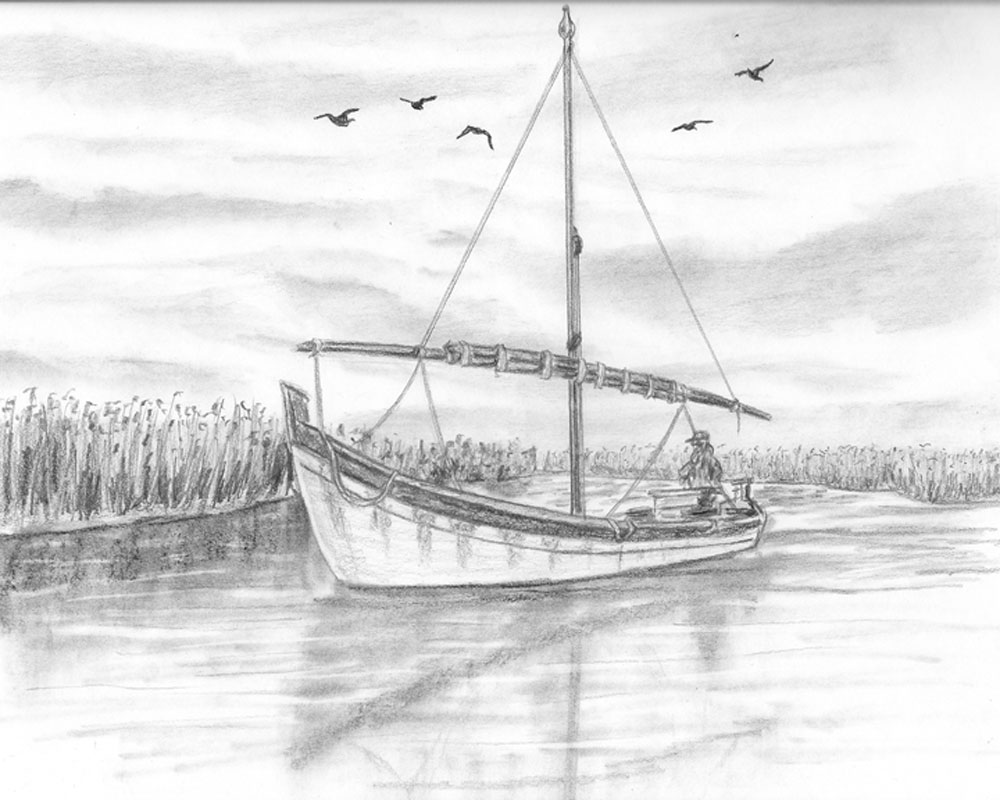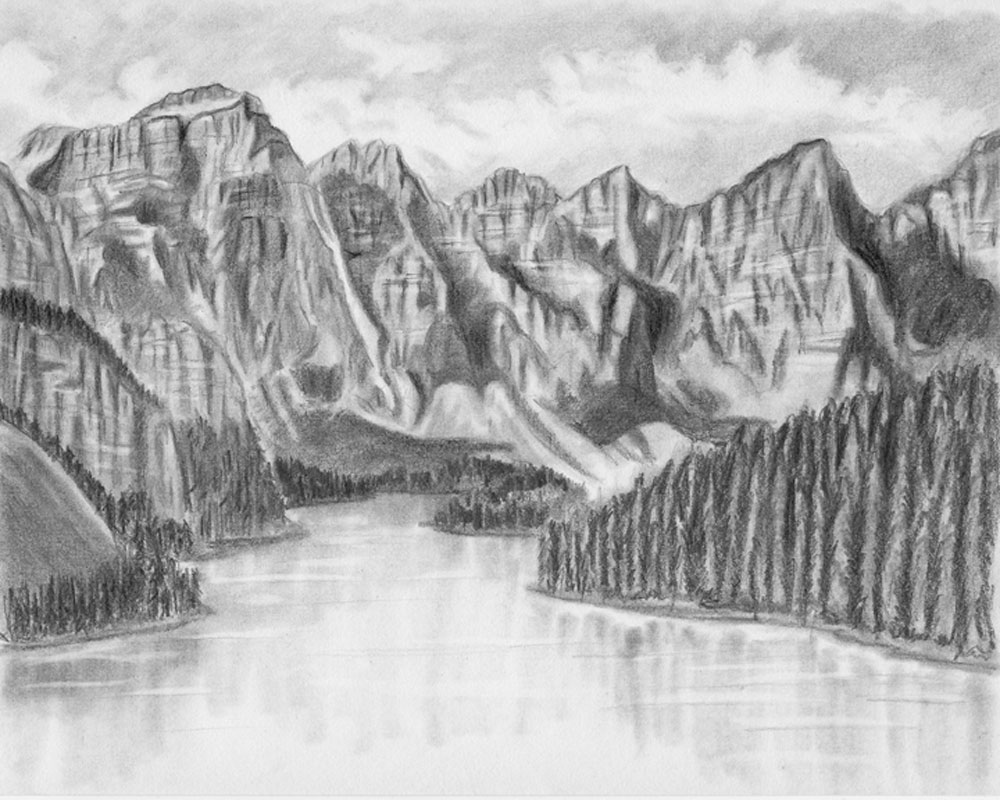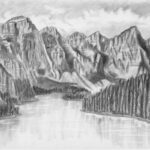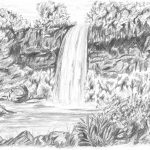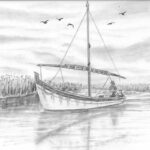Why Paint Them When You Can Be Drawing Landscapes Instead?
Most people think of a landscape as a painting. However, drawing landscapes can produce beautiful works of art, too.
I had a phase earlier in my life when I was fascinated by painting landscapes. I blame Bob Ross for this. He inspired me to get out of my comfort zone and try oil painting. I loved how effortless he made it seem to create beautiful landscape paintings.
This lasted for a couple of years, but eventually I parted ways with it. It was not because I was no longer interested in Bob Ross or landscapes. It was because I rediscovered the medium which I consider my first love…the pencil!
I grew tired of the mess and the need for ventilation and the cleanup that paints required. I welcomed back into my life the simplicity that accompanied the use of pencils to create art.
If you can relate to this story because you also prefer pencils over painting, then please read on!
I will share with you how to combine your love of pencils with a desire to draw landscapes.
Table of Contents
How to Get Started with Landscape Drawings
If you are new to drawing landscapes, one of the best things you can do is pick up a sketchbook and just start filling it with landscape sketches!
There are an endless variety of landscapes from which to choose. To name a few, landscapes can include mountains, cities, oceans, deserts, farms, parks, and forests.
Go out there to the setting of your choice, find a spot to sit, and sketch away. You can also sketch from photographs. Look through your phone for some scenic snaps.
Don’t worry if you don’t know what you are doing. Don’t aim for perfection. Make your sketches brief. Put a time limit to your sketches. Spend no longer than 10-20 minutes on each sketch.
Just sketch regularly. Making a routine out of this exercise will help you to make better observations and improve your drawings over time.
General Tips for Drawing Landscapes
When you are ready to go beyond a rough sketch and draw more detailed landscape pictures, here are a few general tips to help you achieve the look you want.
- Overcome the feeling that you must draw every detail in your landscape scene. It’s okay to simplify things like leaves, water, grass, and distant hills without sacrificing a quality drawing.
- Begin by drawing a simple outline of your landscape. Make sure to draw lightly at first.
- It’s okay to create a scene that differs from your reference. It’s possible that a larger tree, a mountain on the other side of the picture, or a cloudier sky will make for a more interesting composition. Use examples from your current reference or pull other references to achieve this.
- From your landscape outline, layer on tonal shading. Look for areas of light and dark values that are adjacent to each other.
- On top of the tonal shading, start drawing finer details. These details might include more visible foliage or more apparent textures on rocks in the foreground.
In general, work from the distant background toward the foreground. Objects in the background will not be as clear or have as much detail. You can use lighter, harder graphite pencils like an H or even a 4H to shade these. As you shade objects that are closer to the foreground, you can use softer pencils like a 2B or a 4B.
Additionally, some artists find it helpful to sharpen pencils by hand rather than using a traditional pencil sharpener. They carve the wood away with a razor blade to expose more graphite for broad strokes. Also, by moving the tip of the pencil back and forth over sandpaper, they form a flat edge on the graphite. This flat edge can be more useful than a pointier tip for sketching foliage and other common landscape details.
Specific Tips for Drawing Things Found in Landscapes
As you draw more and more landscapes, you are bound to discover that they share many common elements. Here are some pointers to keep in mind as you encounter them.
Drawing the Sky
You can draw a sky by making light shading back and forth with your pencil. Use the side of your graphite for broader strokes. To make clouds, you can carve them out of the sky by lifting the graphite from the paper with a kneaded and plastic eraser.
Alternatively, you can very lightly outline the clouds before you shade the sky. If you do this, be sure to erase the marks when lifting the clouds. Make the tops whiter against the sky, and blend in some light shading with a blending tool.
Drawing Mountains, Rocks, and Hills
Distant mountains and hills will have a haze to them. They will be lighter in value and have less detail than hills and mountains up close.
As you draw rugged mountains and rocks in the foreground, learn to perceive the various planes that exist and make up their surfaces. You can study these planes to distinguish which ones deserve more shading and which ones are receiving more sunlight.
Sketch in some marks to indicate texture for the lighter areas. In other areas, look for where you should draw darker values, cast shadows, and cracks in the rock. Pay careful attention to the curvature of or angles on the surface of the rock to decide how these cracks should flow.
Drawing Trees, Bushes, and Grass
Look at the collective group of leaves on a tree or bush. In order to draw the foliage, break the collection of leaves into smaller sections that are grouped together. Focus on developing one section at a time.
One strategy is to begin with harder pencils and hatch lines. Then, use a softer pencil to layer additional hatch and even crosshatch lines over the first layer. This will produce a resemblance of leaves without you having to draw each individual leaf. When drawing leaves, strike a balance between detail and suggestive marks. However, the decision is up to you as to the level of detail you desire.
Pay attention to where the sunlight is coming from, and leave sunlit areas lightly shaded without extra layers. Place shadows on the opposite side of where sunlight is apparent, like on the underside of leaves. When sketching grass, you can utilize negative space.
Drawing Water
A simple method for drawing still water like a lake is to use graphite from a blending stump for reflections. Simply align the blending stump under the objects along the edge of the lake and pull straight down. Then, use a kneaded eraser to make horizontal streaks that cut across the reflections. These streaks can represent subtle ripples in the water.
For water with more active ripples, you can draw wavy patterns in the water. These wavy patterns should be closer and tighter if they are farther away. They should have more space between them if they are closer in the foreground.
Next, you should shade between some of the water patterns. Pay careful attention to how light or dark any reflected objects are. If the reflected object has a dark value, you should shade on the reflection. If the reflected object has a light value, you should shade the water around the reflection.
Drawing Buildings and Structures
Not all landscapes consist of purely natural elements. The centerpiece of a landscape can just as easily be a man-made bridge, single building, or city skyline.
Study buildings and structures to be more comfortable with various elements of design. Study real-life examples as well as photos.
A terrific strategy for drawing buildings is to use perspective. Perspective drawing involves identifying a horizon line and establishing one, two, or multiple vanishing points.
When drawing buildings and structures, begin by sketching the main shape. Then break this into smaller pieces and focus on adding finer and finer details.
Tutorials for Drawing Landscapes
Here are links to some tutorials on how to draw landscapes. As you can see, landscape drawings can consist entirely of nature elements, or they can include man-made elements too.
Some Final Thoughts on Drawing Landscapes
If you are ever unsure as to what to draw, deciding on a landscape drawing can be a beautiful solution that can bring a lot of satisfaction. Before you start, though, here are a few final thoughts.
As mentioned earlier, visiting scenic locations in person and sketching landscapes from life can do wonders for your observational and perception skills. It can bring more energy and emotion into your overall process as well as the final drawing. This is because you will be drawing a picture of a setting that you are experiencing in real life.
There are a couple of considerations when drawing a landscape from life. First, keep in mind that the same location can look vastly different depending on what time of day or year you are there. The weather of the day can also have an effect on the look of the land. Secondly, remember that Mother Nature will not stay perfectly still while you draw her. A breezy day is certain to blow things out of place. Additionally, the sun will not sit still during your drawing session. Instead, it will distort the placement of your landscape’s shadows as it travels across the sky.
If you choose to draw from life, just allow for these factors and make flexible adjustments in your drawing. There is also nothing wrong with drawing from a photograph while in the comfort of your own home.
Just don’t let anything stop you from creating a beautiful pencil “painting”. Go ahead and start drawing your very own landscapes today!



